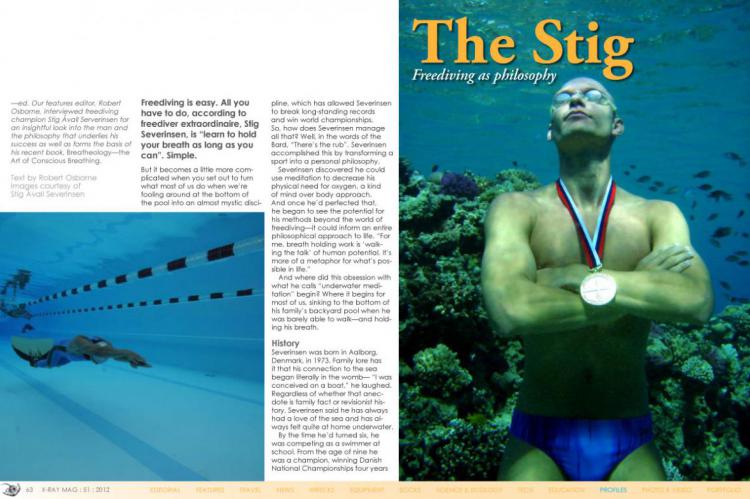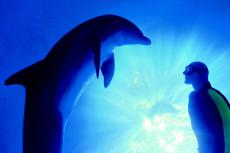Stig Severinsen : Freediving as philosophy
Freediving is easy. All you have to do, according to freediver extraordinaire, Stig Åvall Severinsen, is “learn to hold your breath as long as you can”. Simple.
But it becomes a little more complicated when you set out to turn what most of us do when we’re fooling around at the bottom of the pool into an almost mystic discipline, which has allowed Severinsen to break long-standing records and win world championships. So, how does Severinsen manage all that?
Tags & Taxonomy
Well, in the words of the Bard, “There’s the rub”. Severinsen accomplished this by transforming a sport into a personal philosophy.
Severinsen discovered he could use meditation to decrease his physical need for oxygen, a kind of mind over body approach. And once he’d perfected that, he began to see the potential for his methods beyond the world of freediving—it could inform an entire philosophical approach to life. “For me, breath holding work is ‘walking the talk’ of human potential. It’s more of a metaphor for what’s possible in life.”
And where did this obsession with what he calls “underwater meditation” begin? Where it begins for most of us, sinking to the bottom of his family’s backyard pool when he was barely able to walk—and holding his breath.
History
Severinsen was born in Aalborg, Denmark, in 1973. Family lore has it that his connection to the sea began literally in the womb— “I was conceived on a boat,” he laughed. Regardless of whether that anecdote is family fact or revisionist history, Severinsen said he has always had a love of the sea and has always felt quite at home underwater.
By the time he’d turned six, he was competing as a swimmer at school. From the age of nine he was a champion, winning Danish National Championships four years in a row. By 1993, his powerful obsession with the water progressed to a different venue. Now at university, Severinsen began playing underwater rugby, ultimately becoming part of the Danish National Team. A few years later, while studying at the University of Barcelona, he joined the Spanish National Underwater Hockey Team.
But clearly Severinsen wasn’t spending all of his time with his head underwater. In the midst of all that activity, he somehow found the time to complete a master’s degree in biology and then added a Ph.D. in medicine for good measure.
It goes without saying that most people would look at what Seversinsen had accomplished by the age of 27 and think that it was already an impressive career. But it was only the beginning of Severinsen’s aquatic vocation. As it turns out, his early accomplishments would be a pale shadow of what would come next.
In the year 2000, Severinsen discovered the challenging world of competitive freediving. On top of the physical challenges of the sport and the adrenaline rush it offered, the challenge of controlling the most basic of impulses—breath—sounded a deep inner note in Severinsen’s psyche. Breath-holding dives not only became a challenge to him physically—for the driven young man—it “became a way of getting away from myself”. In order to become really accomplished at the sport, he would learn to “relate more to my heartbeat than my brain functions”.
Meditation
Initially unaware it was even happening, freediving for Severinsen became a form of meditation. He trained himself to slip into a state in which his brainwaves were operating on the alpha level instead of on the more active beta level. Essentially, Severinsen said he was learning to mimic the “mammalian dive reflex”, which whales and sea lions use instinctively.
By dropping himself into that alpha state, he lowered his entire body metabolism—thus using less energy and less air. More than anything, Severinsen credits the ability to achieve this state of mind to his phenomenal success as a freediver: “It’s more important to go into this state for long or deep dives than to have huge capacity in your lungs.”
And just how was Severinsen able to descend into this alpha state while floating in the ocean inhaling massive quantities of air while preparing for what many might describe as nothing less than a horrifically deep dive? Well, in the late 90’s, Severinsen had started to study yoga. And yoga became his secret weapon. He transposed the breathing and meditation techniques he learned from this ancient practice onto the elegant challenge of freediving. The results were impressive.
Championships
Between 2000 and 2007, he won no fewer than four freediving world championships: a gold medal in Switzerland in 2005, gold in Egypt in 2006 and a double gold in Slovenia in 2007.
He also set several world records—among them, a freedive in 2007 to 186 meters without using a set of fins to propel himself. That same year, he set another record by swimming 225 meters distance on one breath.
More recently, he wrote himself into the 2010 Guinness Book of World Records by being the first person to swim 72 meters under the ice without the use of an exposure suit. In 2012, he broke another record by becoming the first human being to hold his breath for 22 minutes.
Anyway you measure it, Severinsen’s combination of yogic breathing and freediving has been enormously successful.
Interestingly, despite being a freediving world champion, Severinsen said he still suffers the same anxieties as any kid holding his breath at the bottom of the pool. “Of course, I still feel that burning desire to head for the surface, but I’ve trained myself to let the diving response kick in.” His belief that feeling fear is inescapable but controlling that fear is quite achievable has become a personal doctrine and a metaphor for life.
Paying it forward
In 2010, Severinsen began to look for another “mountain” to conquer. Given what he had learned about his own ability to use his mind to master his body and accomplish pretty much any goal he set out for himself, Severinsen saw no reason why others could not benefit from the same approach. So, he set out to share some of the knowledge he’d gained.
First, he began to work with elite athletes from around the world including the likes of cyclist Alberto Contador and Olympic gold medalist Martin Kirketerp—not to mention the Danish National Freediving Team and soccer star William Kvist. Severinsen said, when it comes to elite athletes, “Their physical and anatomical differences are not that different.” So, what does make the difference between a champion and an also-ran? Severinsen suggested that one needs to tap into some kind of extraordinary ability.
Amazingly, “For people who manage superhuman efforts, it’s the way they’ve trained their minds.” And with that, we are returned to exactly what Severinsen specializes in—using breathing and meditation to train your mind to go beyond where you believe it can go.
He started with athletes, but soon his client base expanded to include everyone from CEO’s to people with physical disabilities. In each case, Severinsen applied the same wisdom. He worked to teach them how they could transcend their physical limitations with their minds. In the same way he had pushed his mind and body to achieve near superhuman efforts underwater, he showed them how they could accomplish parallel feats in their own personal venues.
The book
Ultimately, Severinsen’s approach to transcending mental limitations was put together in a book. Originally published in Denmark, Breatheology—the Art of Conscious Breathing explains his belief that any one of us can do what he’s done: create a link between the mind and body through proper breathing and drive the self to achieve much more than we ever thought possible. The book was a best-seller and went on to be published in English, Chinese, Spanish and Russian; Arabic and Portuguese versions are in the works.
The philosophy also has a website: Breatheology.com. And Severinsen has recently created a brand new online platform called Breatheology Academy, which gives people instant 24-hour access to training via video exercises.
Certainly, the whole idea seems to have caught fire. Severinsen is on the go virtually 12 months of the year, hopping around the globe, giving talks and running workshops on Breatheology. In a single week he’ll fly between Spain and Hong Kong and the United States—all to promote his concept. His ultimate goal—to have the book translated into as many languages as possible and to have as many people as he can benefit from what he believes is a powerful life tool. Breatheology has taken over his life.
As for freediving, Severinsen simply no longer has the time to compete on the world championship circuit. What training time he does have he devotes to working on achieving still greater underwater breath-holding world records. It seems that having shown thousands of people how to transcend their limitations, he’s run into one of his own—time. ■
Features editor Robert Osborne is an internationally published dive writer, television producer and reporter based in Toronto, Canada.
Download the full article ⬇︎

Originally published
X-Ray Mag #51
Galápagos Islands: two perspectives; Koh Tao, Thailand; Ambon, Indonesia; Bikini Atoll wrecks; Double sinking in Portugal, a first; Stig Åvall Severinsen profile; Hypoxia research; Critters underwater, British Columbia; Dive fitness: Neptune's triceps; Switching to rebreathers; Tips on mirrorless cameras; Plus news and discoveries, equipment and training news, books and media, underwater photo and video equipment, turtle news, shark tales, whale tales and much more...






